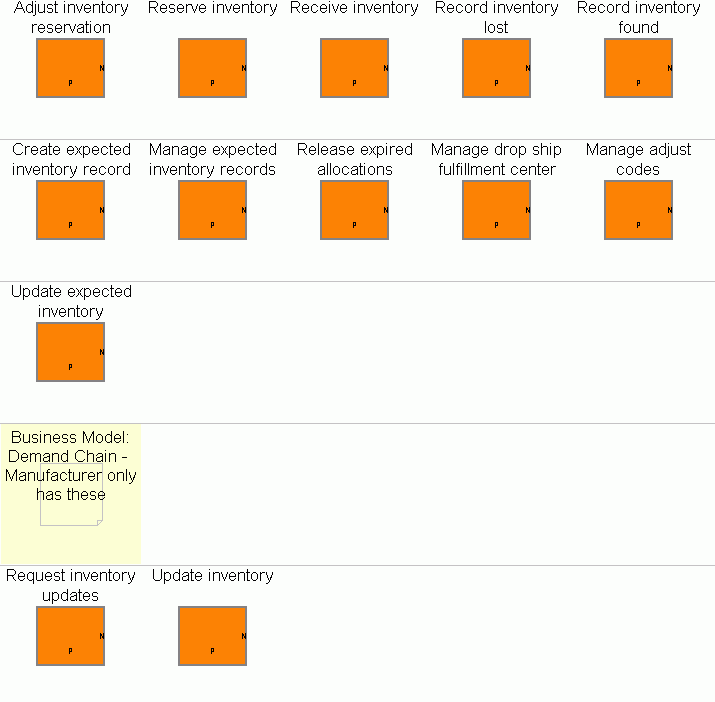Process: Manage inventory
Flow

Objective
Encapsulate processes for the management of inventory.
Description
WebSphere Commerce supports three model of invnetory systems: ATP (availble to promise), non-ATP and no inventory.
Non-ATP inventory is a simple inventory system. It only supports three actions: check inventory, update inventory and reverse update inventory. If the non-ATP inventory is used, the order capture is supported. But many order processing features will not be supported, that is, you will not have backorders, future orders and release to fulfillment, etc. A simple inventory adjustment tool will be provided in the commerce accelerator.
No inventory system is similar to non-ATP with unlimited inventory. That is, the inventory is always available.
ATP inventory system is a function rich inventory management system. It supports many order processing features. The following are descriptions of the ATP inventory management processes.
There are several processes that are involved in inventory management. This includes processes for managing reserves on inventory (prevent it from being allocated to orders), for managing adjustments to inventory, and for managing expected inventory. Expected inventory allows the tracking of inventory that has been ordered as well as what has and has not arrived.
Inventory includes anything that can be physically accounted for in a fulfillment center. There are specific definitions of types of inventory that can be fulfilled, such as items, products, SKUs, bundles, packages, and dynamic kits; but these are all considered inventory.
WebSphere Commerce supports the following inventory-management methods:
- Use WebSphere Commerce to track and manage inventory. This method only takes into account inventory sold through your online store. WebSphere Commerce is unaware of any other method of selling your products.
- Use your existing fulfillment center to track and manage inventory. In this method, the site would configure the messaging system to communicate between WebSphere Commerce and the fulfillment center.
- Use a legacy system.
Available to promise (ATP) provides a mechanism to ensure that commitments made to customers are based on information a seller has about expected inventory as well as inventory currently available. You can manage expected inventory records (anticipation of arrival of inventory from a vendor to a fulfillment center) and track as well as manage inventory.
WebSphere Commerce provides tools to manage inventory:
- Inventory management interface allows the Seller and Consumer Direct Operations Manager or B2B Logistics Manager to track and manage their product inventory.
- Real-time product inventory update as products are ordered or returned by customers.
- Backorder support
- To allow specific products to be backordered, the Product Manager selects Allow Backorder on the Product Fulfillment page of the Product notebook.
- The Product Manager can also force a particular product to be backordered. To do this the Product Manager specifies Force Backorder on the Product Fulfillment page of the Product notebook.
- To see which products are on backorder, run the Products on Backorder report.
- Create an expected inventory record.
- Create ad-hoc inventory receipts for a fulfillment center.
- Receive inventory against an expected inventory receipt for a fulfillment center.
- Check if expected inventory receipt is complete.
- Close expected inventory adjustment for a fulfillment center.
Features
- Available to promise
- Expected inventory
- Inventory adjustment
- Inventory reservation
- Drop-ship fulfillment
- Receive inventory
Edition
Professional, Enterprise
Subprocesses
- Adjust inventory reservation
- Create expected inventory record
- Manage adjust codes
- Manage drop ship fulfillment center
- Manage expected inventory records
- Receive inventory
- Record inventory found
- Record inventory lost
- Release expired allocations
- Request inventory updates
- Reserve inventory
- Update inventory
(C) Copyright IBM Corporation 1996, 2006. All Rights Reserved.